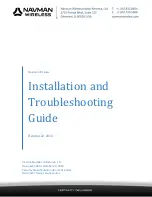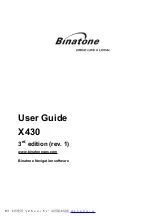
TESTING SIGNAL and RECTIFIER DIODES
Signal and rectifier diodes conduct easily in one
direction and are non-conductive in the opposite
direction. These properties may be tested and ob
served with the curve tracer and oscilloscope. For
testing diodes, the pulsating de sweep voltage is
applied across the diode. The diode current and
voltage are plotted on the oscilloscope screen. The
step current, step voltage signal that was used for
testing transistors and FET's is not used in diode
testing, and the STEP SELECTOR control has no
effect upon the results.
The diode to be tested is plugged into the collector
and emitter pins of the transistor socket, or directly
into the collector (C) and emitter (E) jacks of the
curve tracer; test leads also may be run from the E
and C jacks to the diode terminals. Since the polar
ity of the sweep voltage can easily be reversed with
the POLARITY switch, the diode may be inserted
into the socket without observing polmity. Of course,
diodes inserted at one polmity will produce an oscil
loscope displ
ay
which deflects to the right and up
ward from its starting point, while the opposite polar
ity produces a display which deflects downward and
to the left from its stmting point. A consistent dis
play can be obtained by always connecting the
cathode of the diode to the emitter jack. With this
polarity connection, the POLARITY switch should be
in the NPN position for forward bias of the diode.
The display will be the positive reading type as
shown in Figure 29.
For measuring the forward diode properties, the
oscilloscope horizontal sensitivity should be cali
brated to some low voltage value. A sensitivity of
0.5 volt per division or less is necessary to obtain
any degree of accuracy in the voltage reading. A
calibrated sensitivity of 0.25 volt per division is
easily obtained by using the output of the B, G jack
applied to the horizontal input of the oscilloscope.
Set the STEP SELECTOR at 0.5 volts per step. The
oscilloscope can be adjusted to place the markers
at every other division of the graticule scale.
GERMANIUM-
SILICON
• 1
100, ........... , ............ , ... ,. ....... ,, .......... , ........... , ........... , ............ , ............ , ........... , ........... ,
80; ... ........ , ........... , ..
Io
(ma)
--
.
.
.
.
.
.
.
.
.
.
.
..
.
.
.
.
.
.
.
.
.
0
.5
1
1.5
VF
(volts)
FORWARD BIAS
, ......... .
,···+··
2
2.5
When testing diodes, only one curve is displayed,
not a family of curves as displayed for transistors
�)
and FET's. The forward bias measurements that can
be made are forward voltage drop and diode resist-
ance. As shown in Figure 29, no current flows until
the applied voltage exceeds the junction b
ar
rier.
This forward voltage drop is about 0.3 volt for ger
manium diodes and 0.6 volt for silicon diodes. Above
this point, current increases rapidly with an increase
in forward voltage. The current increases more rap-
idly and the "elbow" has a sharper bend for silicon
diodes than for germanium diodes. The dynamic re
sistance of the diode equals the change in forward
voltage (VF) divided by the change in forward cur-
rent (IF). Germanium diodes, with more slope to
their curves, have higher dynamic resistance than
silicon diodes.
There is no need to increase the SWEEP VOLT
AGE control setting beyond that which gives a full
scale vertical presentation, although there is very
little danger that a higher setting will do harm. The
VERTICAL SENSITIVITY control may be set to the
1 ma/Div position for examining the low current
characteristics, or to a lower sensitivity position,
such as 10 mA/Div, for observing a wider range of
forward current conduction.
The reverse bias condition of a diode may be dis
pl
ay
ed to check leakage (Figure 29). When the
POLARITY switch is set to the opposite position as
used for the forward bias tests, there should be only
a horizontal line displayed. The oscilloscope center-
ing must be readjusted because of the polarity
IJ
reversal causes the trace to move off-screen. Leak-
age current is easier to check with a much higher
voltage than was used for forward bias testing. The
oscilloscope m
ay
be recalibrated for 10 volts per
division, which allows display of the test up to 100
volts. Any measurable current which is displayed
as a slope to the oscilloscope trace can be attributed
to leakage current. If peak inverse breakdown of the
diode occurs below 100 volts, it will be displayed as
L
,.
··
·
··
·
··
·
·
=
:·
···
·
·
·
·
·
··
=
,
·
··
·
·
·
·
·
=F�F,:,n
o
t
........... ..
. ....
;
...........
,
........
.
I
i
LEAKAGE
i
:
:
:
.
·
·
:
2
CURRENT
I
.
'PE!AK
\
��
·
k
·
��E
BREAKDOWN
!
(IF ANY)
,
..................... ,.
(IF
.
REACHED)
'
. .! .
...
.
.
..!
..
.
...... .: ......... .......
..i4
... · ..... · ..... · ......... :, ... .t.·
·
<·
·
· ....... ..
'·:::::::::
::::·
· ..
...
1.········
··•··········
·
:
:
:
100
··
··· ···
eo
·
·
··
·
·
·
·
·
·
··
··
·
·
·
60
··
·
·
····
·
40
(volts)
REVERSE BIAS
+·f
IR
!
(mA)
·········i6
·····18
Figure 29. T
yp
ical Diode Curves
24











































